Authentic German Sauerbraten
This post may contain affiliate links. See my disclosure policy.
One of Germany’s national dishes, this authentic German Sauerbraten features beef roast that is marinated, cooked until fork tender, and served with a wonderfully rich and flavorful sweet-tangy gravy! Serve it with the traditional sides of Rotkohl, potatoes, Semmelknödel, Kartoffelklöße, or Spätzle for a hearty and thoroughly satisfying and unforgettable meal. And whether you’re serving it for a special occasion, casual family gathering, or as part of your Oktoberfest dinner, you’re all set for a memorable feast!
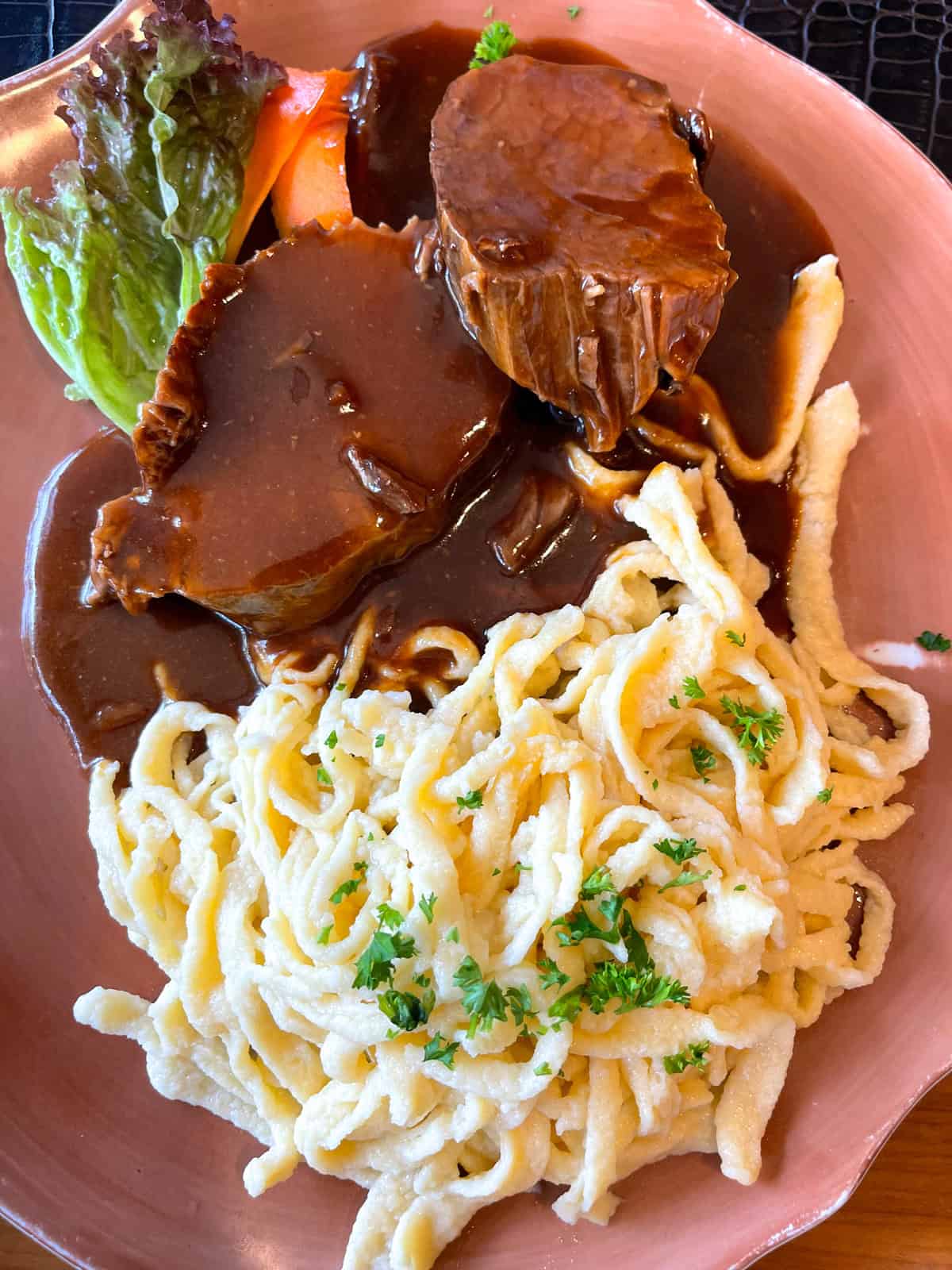
The BEST Sauerbraten Recipe!
Growing up in southern Germany until moving to the U.S. in my mid-20’s, Sauerbraten was a dish I frequently enjoyed and always looked forward to. Both my Mutti and my Oma would make it served with Rotkohl and either Semmelknödel or Kartoffelklöße, sometimes Spätzle, and it was a memorable feast every time. It was also a dish we enjoyed ordering at restaurants, with each region of Germany adding their own touches and variations. Here is a thoroughly authentic Sauerbraten recipe that has garnered rave reviews across the web and remains a firm reader favorite. I’m confident you’re going to love it too.
What is Sauerbraten?
Sauerbraten is a traditional German beef roast that is marinated, browned, and slow-cooked. It is marinated in a mixture of vinegar, wine, spices and herbs over the course of several days which tenderizes the meat and infuses it with its characteristic tangy flavor (hence the name sauerbraten, the German word for “sour roast”).
Sauerbraten is a dish that definitely requires some advance planning as the roast has to marinate for about a week before it’s ready to cook. Don’t cut corners by shortening the marinating time and or holding back on the marinade ingredients. Prepare that amazing marinade, let the meat marinate fully and then reap the rewards for your patience!
Where Did it Originate?
The origin of Sauerbraten has been ascribed to Julius Caesar who is documented as having sent beef marinated in wine all the way from Rome to the new Roman colony of Cologne. Saint Albert the Great of Cologne was later credited with having popularized the recipe in the 13th century. Originally the dish was most commonly made with horse and there are a few restaurants that still serve it, but today it’s primarily made with beef. Less commonly it’s also made with venison or lamb.
This quintessential German dish is found on the menus of many German restaurants both in and outside of Germany. It has been one of Germany’s most popular dishes for generations and as such has become one of its official national dishes.
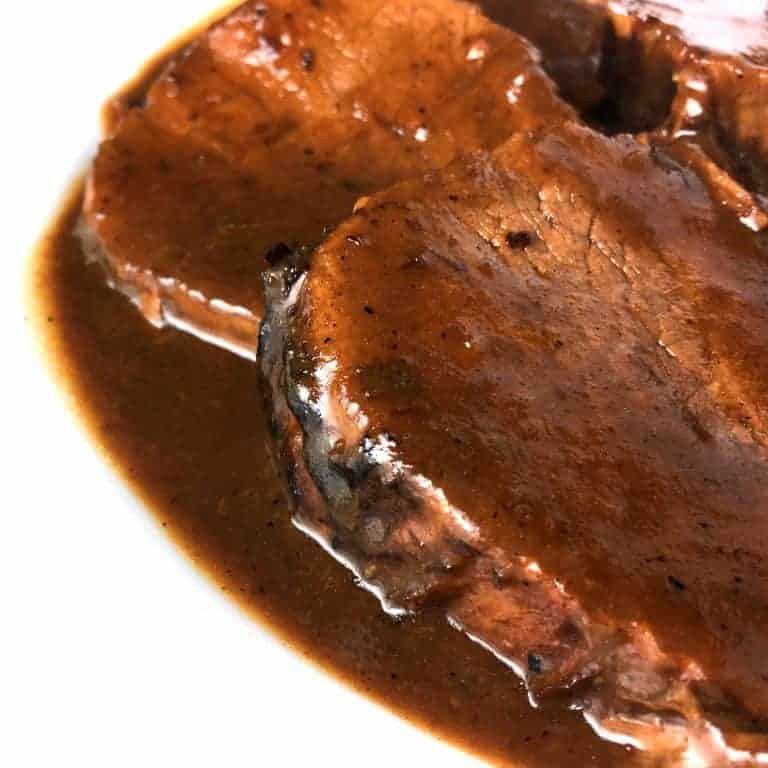
Sauerbraten Ingredients
Sauerbraten recipes vary by region, each adding their own touches. In addition to the sour component there is always the addition of sweet ingredients to balance the acidity and sourness of the sauce. Some regions do this by adding Lebkuchen or ginger snap cookies, raisins, sugar, honey or sugar beet syrup (or often a combination of them) to achieve that balance. To make this traditional Sauerbraten recipe you will need:
- Vegetables: Yellow onions, carrots, leek and garlic go into the marinade and will later be cooked along with the sauce. The leek contributes a fabulous authentic German flavor to the dish so however you may be tempted to omit it, I strongly recommend including it.
- Herbs and Spices: Thyme, rosemary, bay leaves, juniper berries, cloves, peppercorns, salt and sugar all contribute to that authentic Sauerbraten flavor. Juniper berries are very traditional in German cooking, particularly with beef dishes. They contribute a unique woodsy, piney flavor that can’t be replicated any other way. You can buy them online. While I do recommend using them, you can omit them if you can’t find them.
- Red Wine: This forms the bulk of the marinade along with the red wine vinegar. You don’t need an expensive wine because any subtle flavors will be lost in all the seasonings. Choose an inexpensive table wine (but avoid “cooking” wines). Good choices include cabernet sauvignon, merlot or pinot noir.
- Red Wine Vinegar: This creates the “sour” component in Sauerbraten.
- Beef Roast: Tougher cuts like bottom round or rump roast are traditional but you can also use chuck roast for a fall-apart pot roast version.
- Bacon: This is optional and while some variations include it, many do not. I like to include it because that savory-smoky flavor element is fabulous in the final dish.
- Raisins: The inclusion of raisins varies by the region of Germany. Where I’m from in Southern Germany raisins are not included but I occasionally add them because they contribute a really nice flavor and sweetness.
- Ginger Snap Cookies: In Germany things like Lebkuchen or Honigkuchen are traditionally added. Ginger snaps make a great substitute. This adds flavor complexity and sweetness to the dish and also serves as a thickener.
- Honey: This adds sweetness to balance the acidity of the vinegar. Some regions of Germany traditionally use sugar beet syrup instead.
- Flour: To thicken the gravy.
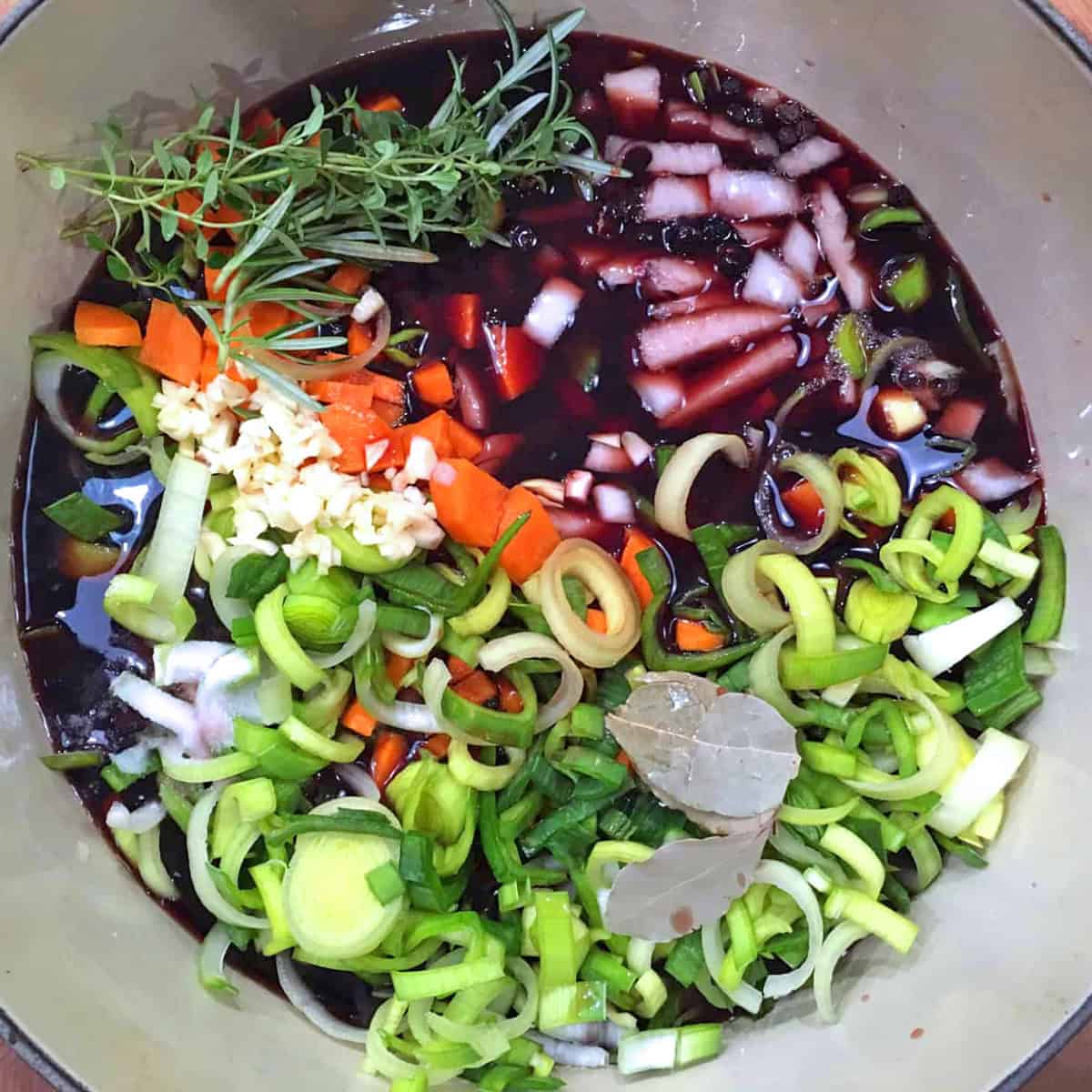
Sauerbraten Recipe
Let’s get started!
Place all of the veggies and herbs in a heavy stock pot or Dutch oven along with the garlic, juniper berries, whole cloves, bay leaves, salt, sugar and peppercorns. Add the red wine, red wine vinegar and water.
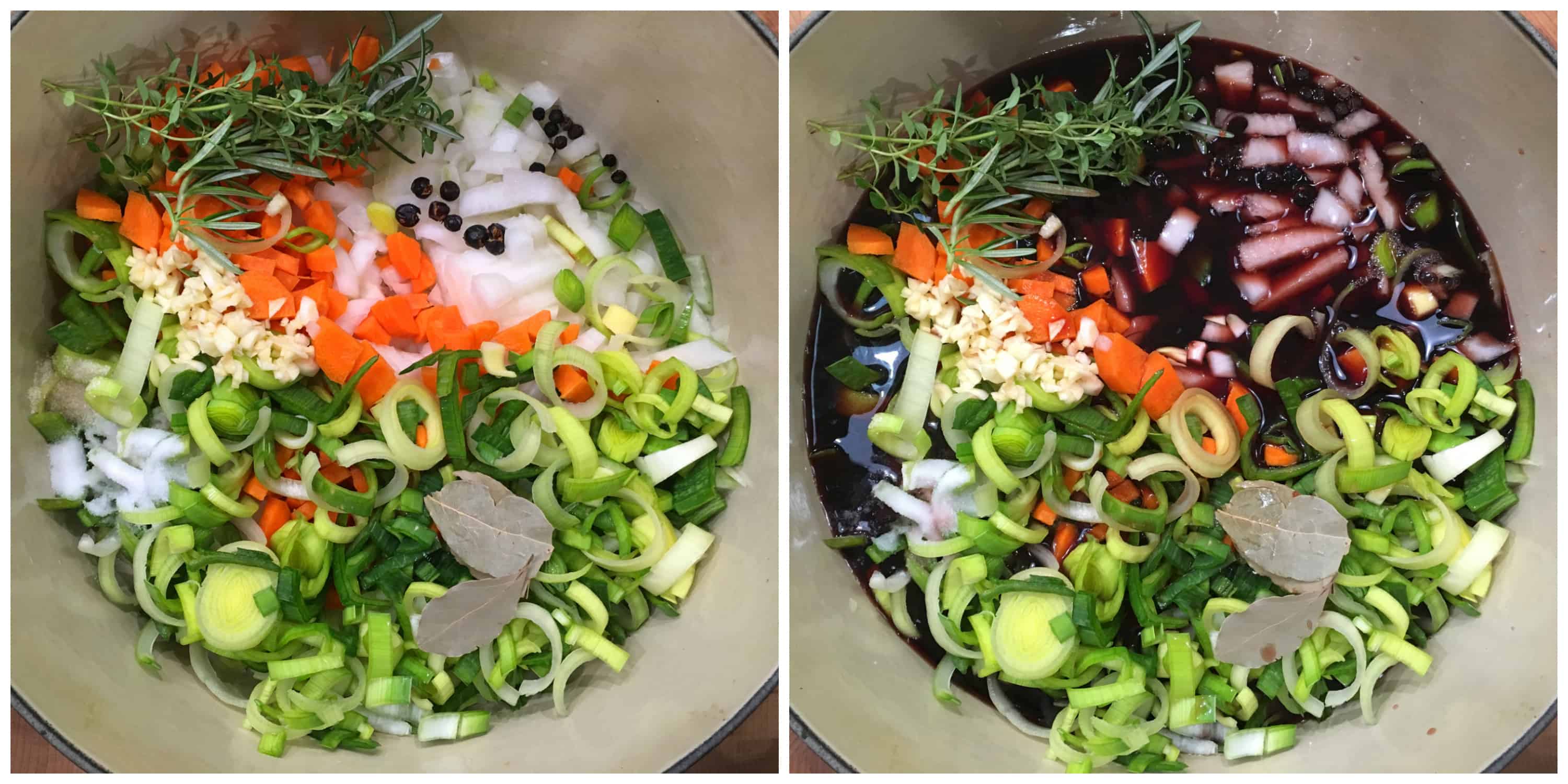
Bring the mixture to a boil, reduce the heat, cover and simmer for 10 minutes. Turn off the heat and let the mixture cool down completely. Nestle the roast in the vegetable marinade and place the lid on the pot.
Let it marinate in the fridge for at least 4 days, preferably 7. (Traditionally, the marinating time is as long as 2 weeks!) Unless the meat is completely submerged under the liquid, turn the roast over once every day.
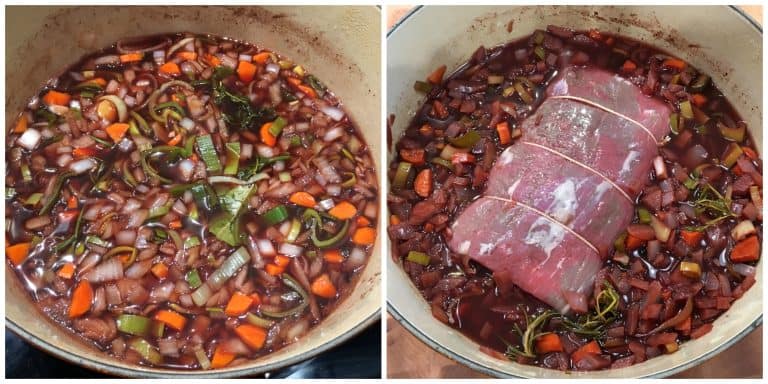
Remove the roast and strain the liquid from the vegetables. Reserve the liquid and the vegetables.
Pat the roast dry with paper towels.
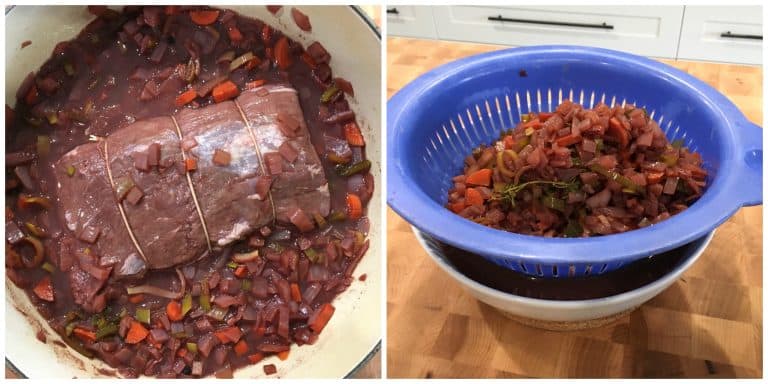
Rinse the pot out and heat a tablespoon or two of oil in it over high heat. Generously brown the roast on all sides.
Remove the roast and set aside. If using bacon, fry the bacon until done.
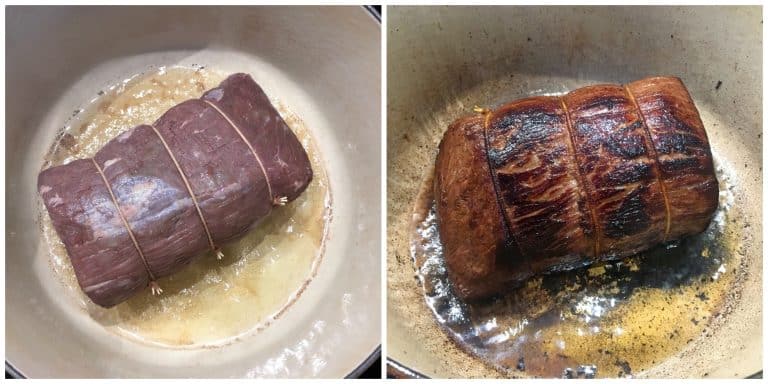
Leave about 2 tablespoons of the oil/fat in the pot. Place the strained vegetables in the pot (along with the bacon if using) and cook for 5-7 minutes. Stir in the flour, cooking the mixture for a minute or two to eliminate the flour flavor. Add the liquid that you strained from the vegetable marinade, bring it to a boil, stirring constantly to prevent lumps.
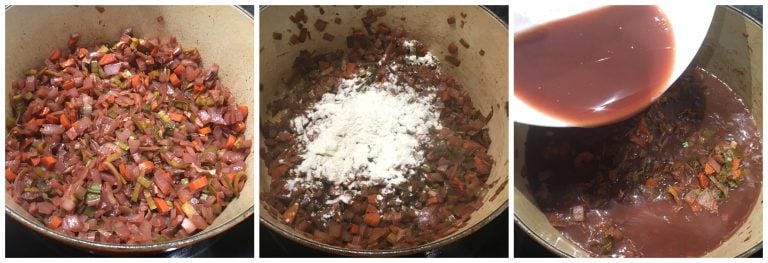
Add the raisins, honey and crushed ginger snaps. Return the roast to the pot.
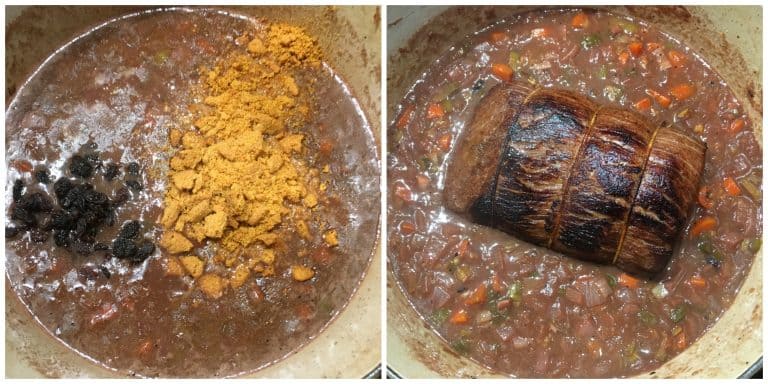
Bring to a boil, reduce the heat to low, cover and simmer for 2-4 hours or until the meat is very tender. Cooking time will vary depending on the type of roast and how long the roast marinated. It takes a while for the tough connective tissues in the meat to get up to temperature to start breaking down, so if the beef isn’t tender continue cooking it.
Note: The longer you let the roast marinate the faster it will cook because the meat will be more tender from the start. So check on your roast periodically for doneness.
When the roast is done, remove and transfer it to a plate and let it rest for 5 minutes before slicing. In the meantime, strain the gravy.
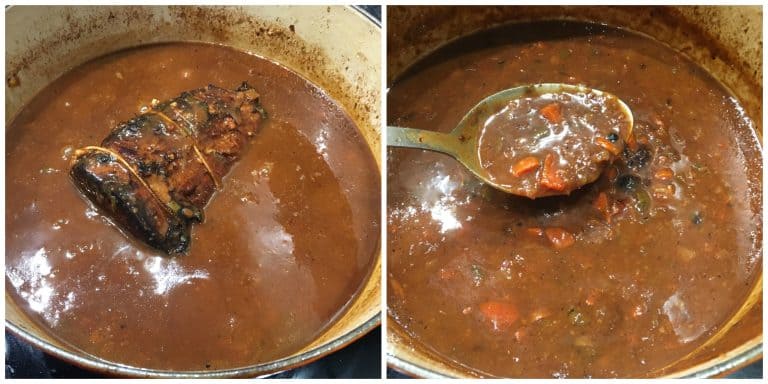
Strain the gravy and return it to the pot. Taste and more sugar, salt and pepper as desired. If you want your gravy thicker, make a cornstarch slurry to thicken the gravy.
Note: The balance of sour to sweet is a matter of personal taste – adjust the flavor according to your preference. If the flavor is too strong for you, you can also dilute it with a little water or broth.
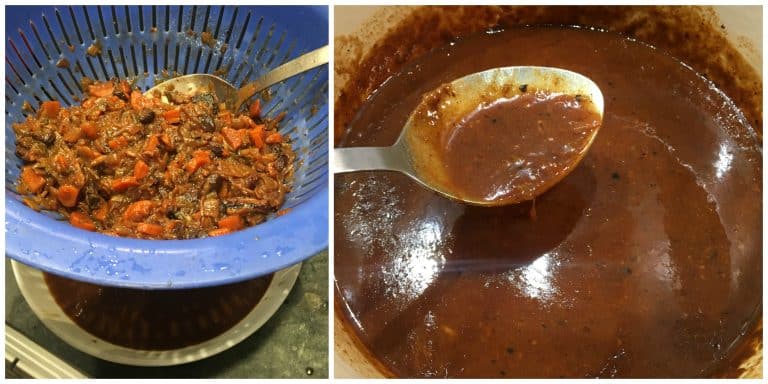
Let the roast rest for 5 minutes after removing it from the pot. Then slice the roast.
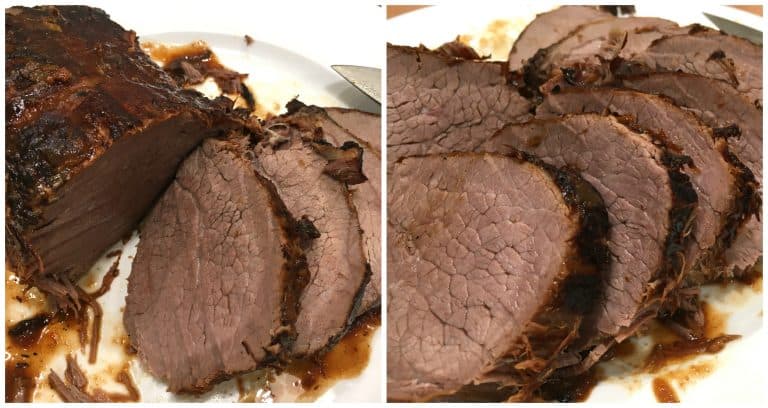
Spoon the hot gravy over the sliced Sauerbraten and serve immediately.
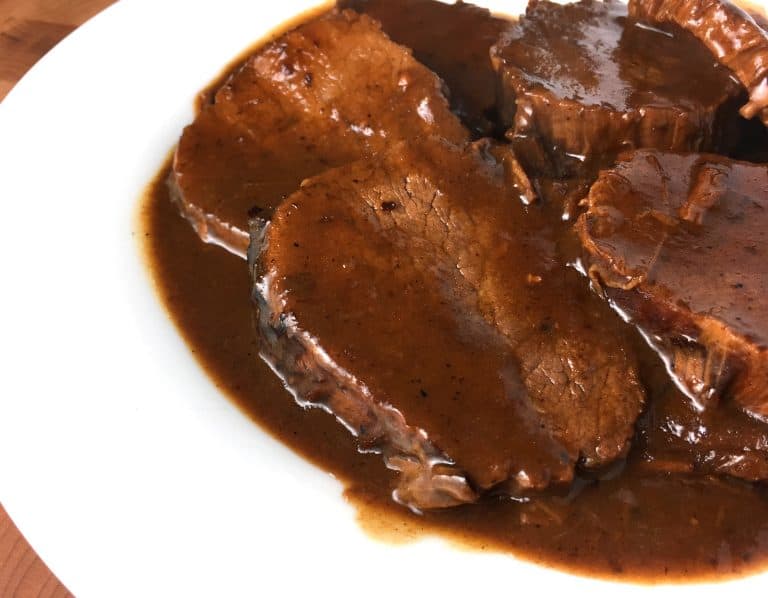
What to Serve with Sauerbraten
There are several traditional sides you can serve with Sauerbraten. These include:
- Kartoffelklöße – these are German potato dumplings and they are popular throughout every region of Germany. They’re made from potatoes and are pillowy soft, making them perfect for mopping up that luscious gravy.
- Semmelknödel – another traditional dumpling, these are bread dumplings seasoned with herbs. These are especially popular in southern Germany where they originated but are served throughout the country.
- Spätzle – the famous noodles from the Swabia region of southern Germany (where I’m from), and when you’re in Baden-Württemberg and order Sauerbraten this is the most popular accompaniment.
- Kartoffelpuffer – where I’m from in Swabia these German potato pancakes are served with sweet accompaniments but in other regions, such as Rhineland-Palatinate, they’re also served as accompaniments to savory dishes, like sauce-based meat dishes. In the case of Sauerbraten, I would serve them in addition to one of the dumpling options or Spätzle.
- Boiled or mashed potatoes – not as exciting as the options above but still perfectly acceptable :)
- Rotkohl – this braised German red cabbage is a must. It is the quintessential traditional side for roast beef in Germany.
- German Potato Salad – definitely the Swabian or Bavarian oil-and-vinegar potato salad varieties, not the mayo-based kind.
- Creamy German Cucumber Salad or the vinegar-based German Cucumber Salad (Gurkensalat) – either of these make a really nice and refreshing accompaniment.
- German Tomato Salad (Tomatensalat), Krautsalat (German cabbage salad), or Bohnensalat (German bean salad)
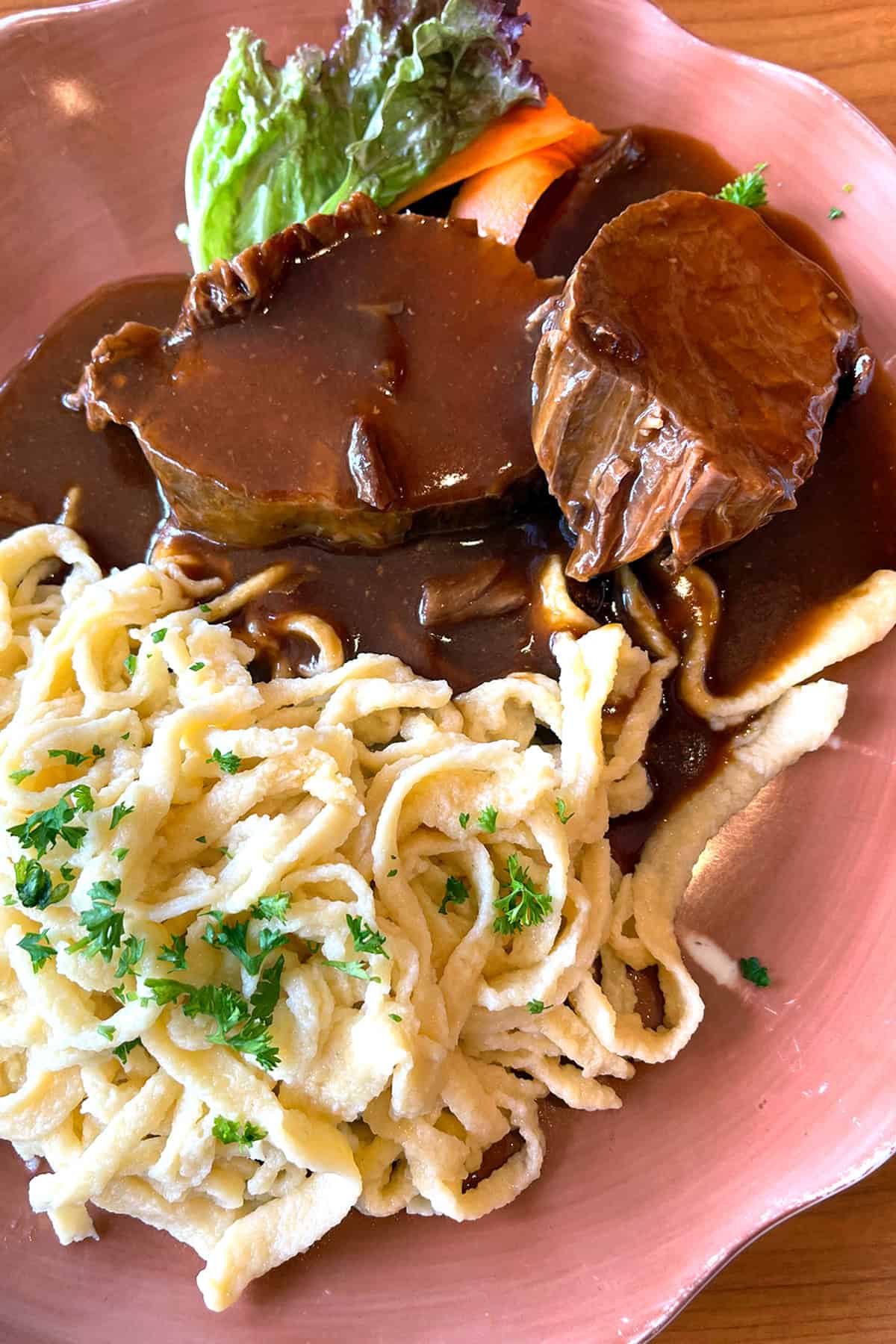
Storage and Reheating
Sauebraten can be made in advance and reheated. I like to pre-slice the meat and store it in some of its gravy to preserve moisture, and then reheat it along with the remaining gravy to serve at the table. It will keep in the fridge for 3-4 days and can be gently reheated in the microwave in a covered container, on the stovetop, in a crockpot, or in the oven.
Sauerbraten can also be frozen. Pre-slice the roast, let it fully cool, and freeze it with the gravy in a freezer-safe container for up to 3 months. Let it thaw slowly in the refrigerator and then gently reheat.
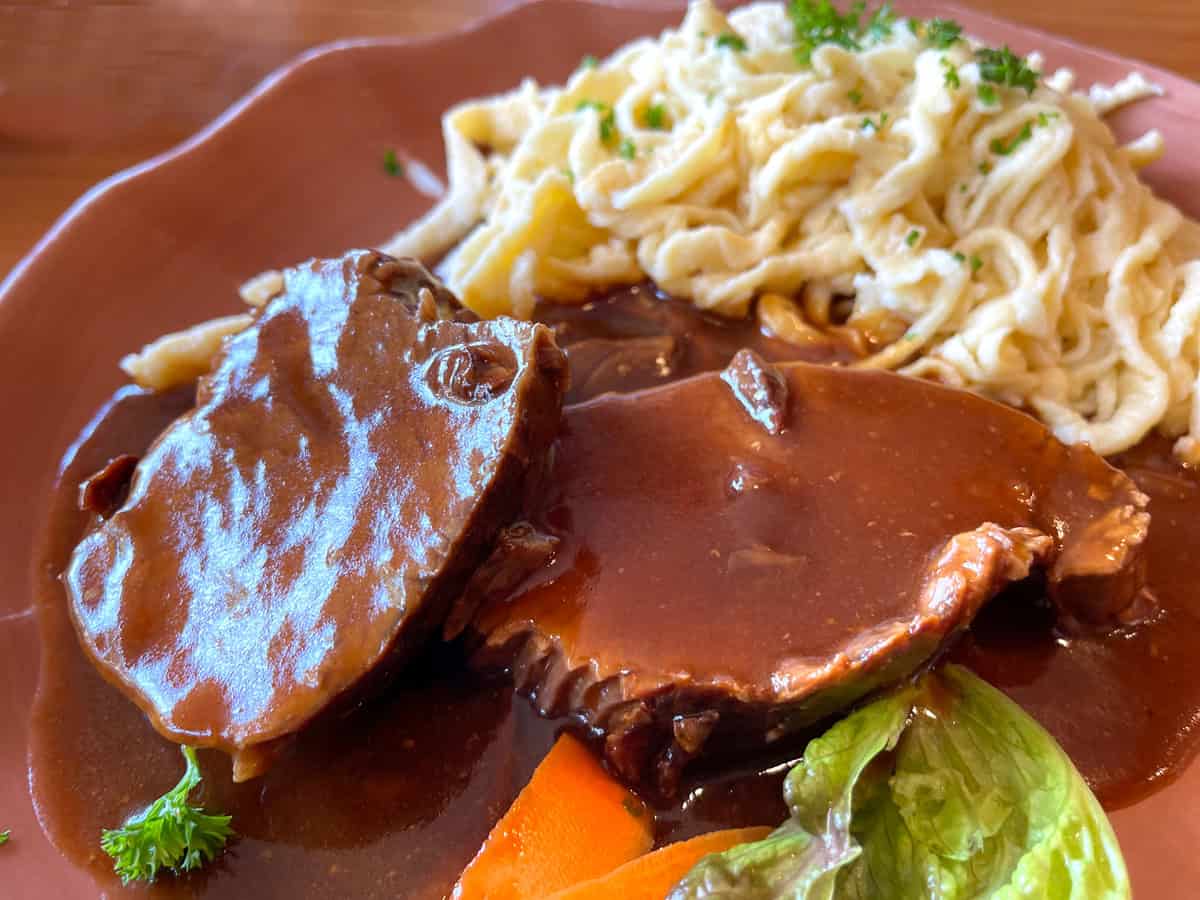
For more delicious German recipes be sure to try my:
- Schnitzel
- Jägerschnitzel
- Königsberger Klopse
- Senfbraten
- Schweinshaxe
- Maultaschen
- German Potato Soup
- Frikadellen
- Currywurst
- Käsespätzle
- German Sauerkraut Soup
- German Bread (Vollkornbrot)
Save This Recipe
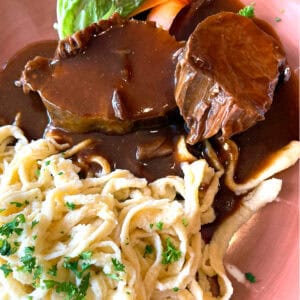
Authentic German Sauerbraten
Equipment
Ingredients
- 2 large yellow onions , chopped
- 2 large carrots , diced
- 1 large leek , chopped, thoroughly washed and drained to remove any dirt
- 3 cloves garlic , minced
- 2 large sprigs thyme , or 1 teaspoon dried
- 2 small sprigs rosemary , or 1 teaspoon dried
- 2 bay leaves
- 8 juniper berries , cracked
- 6 whole cloves
- 10 whole black peppercorns , cracked
- 2 1/2 teaspoons salt
- 1 teaspoon sugar
- 2 1/2 cups dry red wine (e.g., cabernet sauvignon, merlot, pinot noir)
- 1 cup red wine vinegar
- 1 1/2 cups water
- 4 pounds beef roast (tougher cuts like bottom round or rump roast are traditional but you can also use chuck roast)
- 4 slices bacon , finely diced (optional); some variations include but most do not
- 4 tablespoons all-purpose flour
- 1/4 cup raisins
- 3 ounces ginger snap cookies , crumbled
- 1 tablespoon honey
Instructions
- Prepare the Marinade: Place all of the veggies and herbs in a heavy non-reactive stock pot or enameled Dutch oven along with the garlic, juniper berries, whole cloves, bay leaves, salt, sugar and peppercorns. Add the red wine, red wine vinegar and water.Bring the mixture to a boil, reduce the heat, cover and simmer for 10 minutes. Turn off the heat and let the mixture cool down completely.
- Marinate the Meat: Nestle the roast in the vegetable marinade and place the lid on the pot.Let it marinate in the fridge for at least 4 days, preferably 7. (Traditionally, the marinating time is as long as 2 weeks!) Unless the meat is completely submerged under the liquid, turn the roast over once every day.Remove the roast, pat it dry with paper towels, and strain the liquid from the vegetables. Reserve the liquid and the vegetables.
- Cook the Roast: Rinse the pot out and heat a tablespoon or two of oil in it over high heat. Generously brown the roast on all sides. Remove the roast and set aside. If using bacon, cook the bacon until done. Leave about 2 tablespoons of oil/fat in the pot. Place the strained vegetables in the pot (with the bacon if using) and cook for 5-7 minutes. Stir in the flour, cooking the mixture for a minute or two to eliminate the flour flavor. Add the liquid that you strained from the vegetable marinade, bring it to a boil, stirring constantly to prevent lumps.Add the raisins, honey and crushed ginger snaps. Return the roast to the pot.Bring to a boil, reduce the heat to low, cover and simmer for 2-4 hours or until the meat is very tender. Cooking time will vary depending on the type of roast and how long the roast marinated. (Note: The longer you let the roast marinate the faster it will cook because the meat will be more tender from the start. So check on your roast periodically for doneness.)When the roast is done, remove and transfer it to a plate, tent it to keep warm, and let it rest for 5 minutes before slicing.
- Prepare the Gravy: While the roast is resting, strain the gravy and return the gravy to the pot. Taste and more sugar, salt and pepper as desired. If you want your gravy thicker, make a cornstarch slurry to thicken the gravy. (Note: The balance of sour to sweet is a matter of personal taste – adjust the flavor according to your preference. If the flavor is too strong for you, you can dilute it with a little water or broth.)Spoon the gravy over the sliced Sauerbraten and serve immediately.
- Serve with Rotkohl and boiled potatoes, Spätzle, Semmelknödel or Kartoffelklöße . A few parts of Germany even serve it with Kartoffelpuffer.
Nutrition
Originally published October 2, 2018



















iam german and no one i know in germany uses ginger snaps in anything. Nor do they use apple cider vinegar in ANYTHING.
Ilona, either you’ve lived all your life under a rock or you’ve lived away from Germany for so long that you’ve forgotten how Germans cook. Printen or Lebkuchen are very common additions to Sauerbraten in certain regions of Germany and here in the U.S. ginger snaps are a good substitute. As for Germans not using apple cider vinegar (Apfelessig) in “ANYTHING”….seriously?? I refer you back to my opening statement.
Hallo Ilona, ich stimme Kimberley zu. Keine Ahnung, ob du selber kochst, aber in meiner Küche findet sich Apfelessig. Und mit Lebkuchen Saucen zu würzen oder anzudicken, ist eine traditionelle Methode hier in Deutschland. Schon seit dem Mittelalter. Kimberley, I really love you recipes! They are authentic and totally scrumptious. Though, it’s funny to find a recipe for toast Hawaii on an American page. The curse of my childhood in the 70th. ;-) Herzlichen Dank!
Vielen Dank, Maria! And Hawaii Toast….hahahaha, yes!! :)
@Ilona
Ich weiß ja nicht wo du herkommst, aber hier bei uns in Franken ist es undenkbar, einen Sauerbraten ohne Lebkuchen zu kochen. Es gibt sogar extra Soßenlebkuchen (Leupold’s) in jedem Supermarkt. Der wird genauso auch für diverse Wildgerichte, Soßen und manchmal sogar Rotkraut verwendet. Ist ja nicht schlimm, das nicht zu wissen, aber dann wäre ich mit solch pauschalen Kommentaren eher vorsichtig.
@ Kimberly
Thanks for the wonderful recipe. I have been cooking Sauerbraten for all of my life and would never have dreamt of finding new inspiration on an American website;-)
Das freut mich, Martin, vielen dank! :)
I’ve been making sauerbraten (Alton Brown’s) for years and because your other recipes are so delicious, decided to try yours. I seared the meat before brining it (3 days), used 5 lbs. of eye round, and cooked it in the oven for 325 for 4 hours in a covered dutch oven. I strained the veggies out of the gravy after cooking it, and then thickened the gravy on the stove with the ginger snaps. I also used the bacon. What can I say…this recipe was seriously incredible! My family LOVES good German food with a passion, and we all agreed that this was the best sauerbraten any of us has ever had. The only change I would make in the future would be to double up on the gravy. More to go around, for the kartoffelkloesse, potatoes, spaetzle, etc. Mmmmmmm! Many thanks for another amazing recipe!
Thank you so much, Meredith, I’m absolutely thrilled to hear that!
Hi, Can I use cooking red wine for this recipe
Hi Etta, yes you can use red wine instead of white, though it will of course yield a different flavor profile.
Thank you so much
Just wondering why the gravy looks smooth if you’re not blending the vegetables/gravy? I see one person who commented that they did use a blender for gravy and I’m thinking that would look and taste better. I have this marinating now for a Saturday dinner. Can’t wait!
Hi Dawne, I personally don’t puree and add the veggies to my gravy. I prefer to just eat them on the side and keep the gravy smooth and more translucent. You can certainly add them to the gravy if you prefer that texture, but doing so won’t enhance gravy’s flavor as all the flavors from the vegetables are already present through the long cooking time. I hope you enjoy the Sauerbraten!
Thank you for responding, one more question. I’m having German Day tomorrow and this beef has been marinating in my fridge for a week!! Can’t wait to make it but wondering if I can cook in the morning and Reheat later. I hate having to cook while my guests are here.
Hi Dawne, yes you can do that, it reheats well.
Can I bake this in the oven for two hours.?
Thank you,!
Ellen
Hi Ellen, yes you can. I’d aim for 325 F for 2 1/2 to 3 hours (as soon as it’s fork tender).
I can’t wait to make this dish, one of my childhood favourites. My German mother would make this on special occasions along with the rotkohl and spaetzle. My brother is coming to visit for the first time in 20 years and this will knock his socks off! Thank you so much for sharing.
What cut of meat do you recommend if only able to marinate for 3 days? I’ll know next time I make this recipe to start it a week ahead of time! 😊
As specified — 3 days is a lower limit. Lowest I’ve seen is 48 hours. You’re good to go.
I always use a Rump roast, it’s lean and always tastes delicious!
I am planning a meal for 100 people this fall using this as a side dish. Should I just multiply the ingredients proportionately or do you have any mass serving size recommendations? I will be trying the recipe ( single batch) this weekend. Looking forward to trying this recipe!